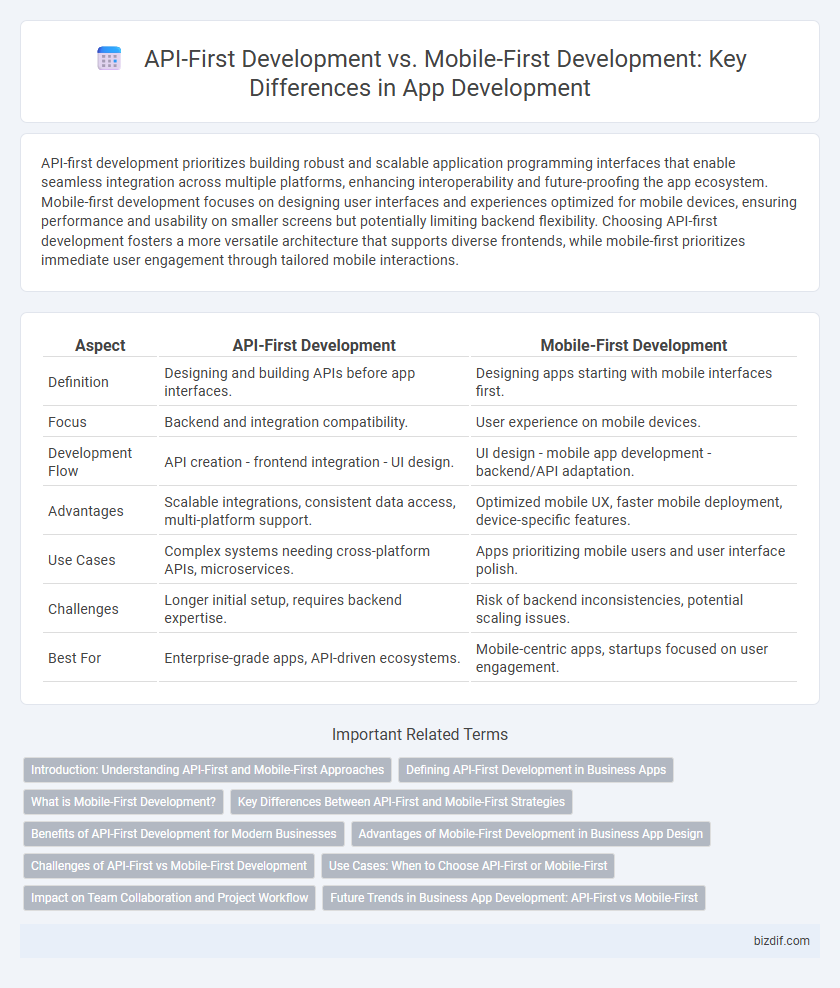API-first development prioritizes building robust and scalable application programming interfaces that enable seamless integration across multiple platforms, enhancing interoperability and future-proofing the app ecosystem. Mobile-first development focuses on designing user interfaces and experiences optimized for mobile devices, ensuring performance and usability on smaller screens but potentially limiting backend flexibility. Choosing API-first development fosters a more versatile architecture that supports diverse frontends, while mobile-first prioritizes immediate user engagement through tailored mobile interactions.
Table of Comparison
| Aspect | API-First Development | Mobile-First Development |
|---|---|---|
| Definition | Designing and building APIs before app interfaces. | Designing apps starting with mobile interfaces first. |
| Focus | Backend and integration compatibility. | User experience on mobile devices. |
| Development Flow | API creation - frontend integration - UI design. | UI design - mobile app development - backend/API adaptation. |
| Advantages | Scalable integrations, consistent data access, multi-platform support. | Optimized mobile UX, faster mobile deployment, device-specific features. |
| Use Cases | Complex systems needing cross-platform APIs, microservices. | Apps prioritizing mobile users and user interface polish. |
| Challenges | Longer initial setup, requires backend expertise. | Risk of backend inconsistencies, potential scaling issues. |
| Best For | Enterprise-grade apps, API-driven ecosystems. | Mobile-centric apps, startups focused on user engagement. |
Introduction: Understanding API-First and Mobile-First Approaches
API-first development prioritizes designing and building robust, scalable application programming interfaces that enable seamless integration and flexibility across multiple platforms. Mobile-first development emphasizes creating user-centric applications optimized for mobile devices, ensuring responsive design and superior performance on smaller screens. Understanding these approaches helps developers choose strategies that best align with project goals, whether focusing on backend service architecture or front-end user experience.
Defining API-First Development in Business Apps
API-first development in business apps emphasizes designing and building application programming interfaces (APIs) before developing the user interface or backend services. This approach ensures seamless integration, scalability, and consistent data exchange across multiple platforms and devices. Prioritizing API design enhances collaboration between development teams and accelerates time-to-market for mobile and web applications.
What is Mobile-First Development?
Mobile-first development prioritizes designing and building applications starting with mobile devices before scaling up to larger screens. This approach ensures optimal performance, user experience, and interface design suited for smaller screens, touch interactions, and limited resources. Emphasizing responsive design and mobile usability drives higher engagement and accessibility across diverse mobile platforms.
Key Differences Between API-First and Mobile-First Strategies
API-first development prioritizes designing and building robust APIs before creating the user interface, enabling seamless integration and scalability across multiple platforms. Mobile-first development focuses on crafting the user experience primarily for mobile devices, ensuring optimized performance and usability on smaller screens. Key differences include API-first's emphasis on backend architecture and reusability, while mobile-first centers on frontend design and responsive user interaction.
Benefits of API-First Development for Modern Businesses
API-first development enables modern businesses to create scalable, flexible digital ecosystems by prioritizing the design and deployment of robust APIs before building applications, ensuring seamless integration across multiple platforms. This approach accelerates development cycles, improves collaboration between frontend and backend teams, and supports omnichannel customer experiences by providing consistent data access. Companies adopting API-first strategies gain competitive advantages through enhanced adaptability to emerging technologies and faster time-to-market for new features.
Advantages of Mobile-First Development in Business App Design
Mobile-first development enhances user experience by prioritizing performance and usability on smaller screens, which drives higher engagement and customer retention in business apps. It supports faster load times and smoother interactions, crucial for on-the-go users who rely on mobile devices for business tasks. This approach also facilitates responsive design, ensuring consistent functionality across all devices, improving brand perception and expanding market reach.
Challenges of API-First vs Mobile-First Development
API-first development faces challenges such as ensuring robust and consistent API design that meets diverse client needs while managing evolving backend requirements and security concerns. Mobile-first development encounters difficulties in optimizing user experience across multiple devices and platforms, balancing performance constraints, and integrating backend services effectively. Both approaches require careful coordination between frontend and backend teams to prevent misalignment and ensure seamless communication.
Use Cases: When to Choose API-First or Mobile-First
API-first development suits projects requiring scalable integrations, multi-platform support, or rapid backend iterations, enabling seamless data sharing across web and mobile interfaces. Mobile-first development excels in user experience optimization for smartphone users, prioritizing responsive design and performance on limited device resources. Choose API-first when backend flexibility and cross-device compatibility are critical, while mobile-first is ideal for apps heavily dependent on intuitive UI and local device capabilities.
Impact on Team Collaboration and Project Workflow
API-first development enhances team collaboration by enabling backend and frontend teams to work in parallel through well-defined interface contracts, reducing dependencies and streamlining project workflows. Mobile-first development prioritizes UI/UX design and front-end performance, often requiring iterative adjustments between designers and developers that can slow cross-functional coordination. By adopting an API-first approach, organizations achieve more predictable timelines and clearer communication across distributed teams, optimizing overall project efficiency.
Future Trends in Business App Development: API-First vs Mobile-First
API-first development prioritizes scalable and flexible integrations, enabling seamless connectivity across diverse platforms and driving future-proof business apps. Mobile-first development focuses on optimizing user experience for smartphones and tablets, which remains crucial as mobile traffic continues to dominate global internet usage. Emerging trends highlight a hybrid approach where robust APIs support dynamic mobile interfaces, accelerating innovation and responsiveness in enterprise app ecosystems.
API-first development vs Mobile-first development Infographic

 bizdif.com
bizdif.com